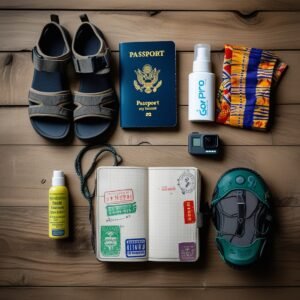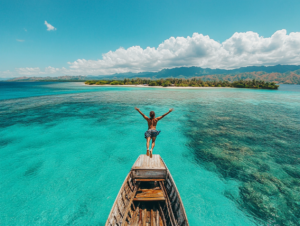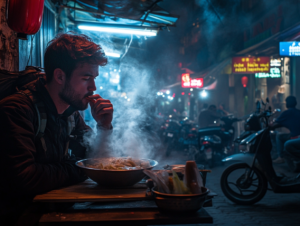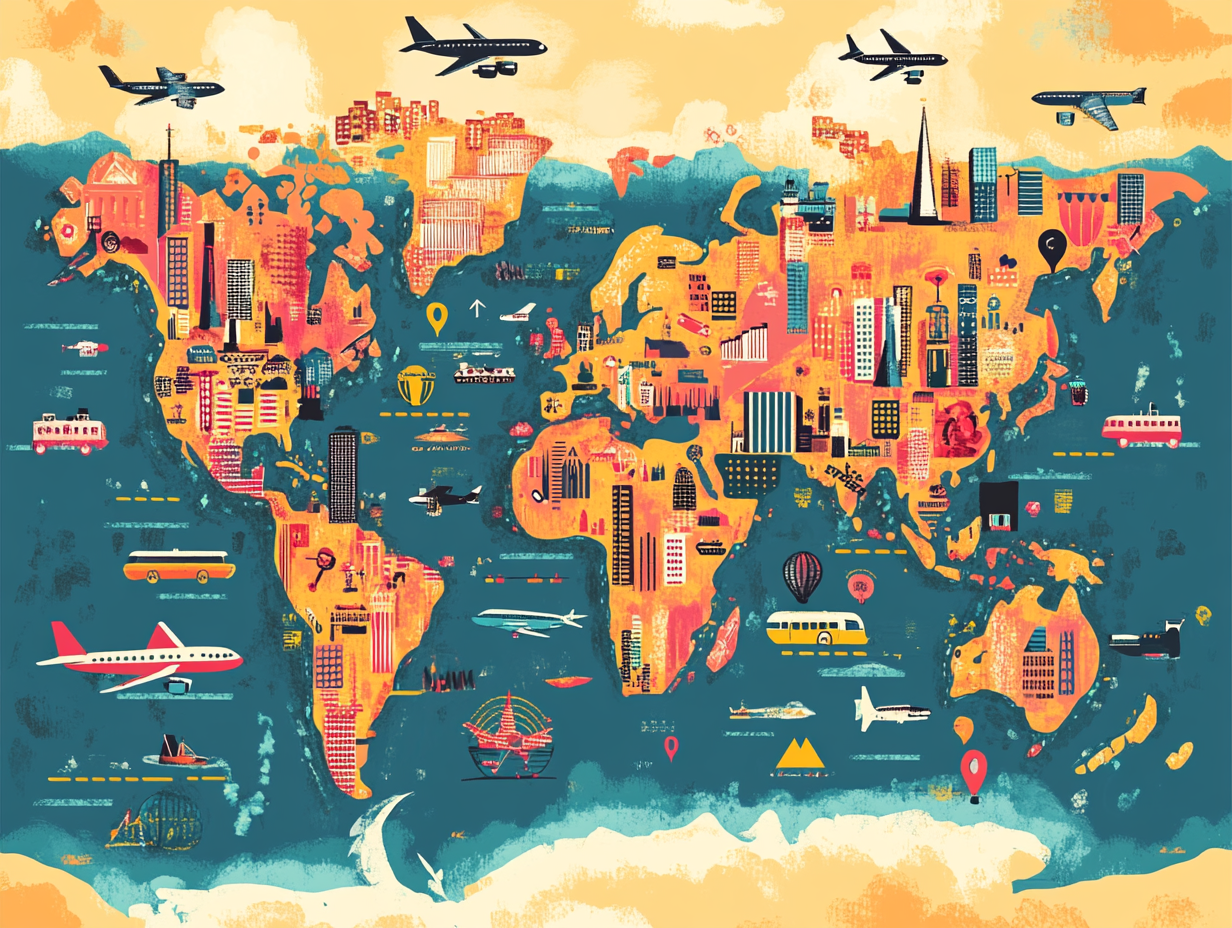Introduction to Southeast Asia Backpacking
Southeast Asia has emerged as a premier destination for backpackers seeking a unique blend of adventure, culture, and affordability. The region is renowned for its rich cultural diversity, which manifests in the languages spoken, the festivals celebrated, and the culinary delights offered in each country. From the bustling streets of Bangkok to the serene beaches of Vietnam, backpackers are rewarded with a multitude of experiences that cater to varying tastes and preferences.
A significant draw for many travelers is the relative affordability of exploring Southeast Asia. Prices for accommodation, food, and transportation remain low compared to other popular travel destinations, allowing backpackers to stretch their budgets while still enjoying comfortable lodgings and authentic local cuisine. This economic advantage has fostered a vibrant backpacking community where individuals can meet, share stories, and embark on journeys together, forging connections that can last a lifetime.
The stunning landscapes across the region contribute to its popularity as a backpacking haven. From the lush rainforests of Malaysia to the breathtaking temples of Angkor Wat in Cambodia, the natural beauty and historical significance create an immersive environment for exploration. Furthermore, the diversity of activities available—ranging from trekking in the hills of Northern Thailand to experiencing the vibrant nightlife in Kuala Lumpur—invites travelers to customize their itineraries according to their interests, thus enhancing overall satisfaction.
Planning a backpacking route through Southeast Asia is essential for a seamless and enriching adventure. With several countries and countless attractions to consider, a well-thought-out itinerary can make the difference between a haphazard trip and a memorable exploration of this captivating region. By taking the time to research and outline their journey, backpackers can ensure they experience the very best Southeast Asia has to offer.

Essential Packing Tips for Your Journey
Packing for a three-month backpacking journey through Southeast Asia requires careful consideration of various factors, including climate, activities, and personal needs. The diverse weather and terrain across the region necessitate a versatile wardrobe and practical gear. Start by selecting lightweight, breathable clothing made from quick-drying materials. Consider packing a combination of T-shirts, shorts, and lightweight pants, as well as a long-sleeved shirt for sun protection and cooler evenings. Lightweight, packable rain jackets are also essential, given the potential for sudden rain showers in tropical climates.
In terms of footwear, it is advisable to bring a sturdy pair of hiking shoes or sandals that provide good support for long treks, as well as a pair of comfortable shoes for casual outings. Additionally, remember to pack a small first aid kit stocked with essentials such as adhesive bandages, antiseptic wipes, and pain relievers. Having basic medical supplies on hand can be particularly beneficial in remote areas where access to healthcare may be limited.
A versatile packing system can greatly enhance your traveling experience. It is recommended to utilize packing cubes or compression bags to compartmentalize your belongings and save space within your backpack. This approach fosters organization and makes it easy to access items without uprooting your entire pack. Travel gadgets can also improve your journey; consider a power bank for keeping electronics charged, a universal adapter suitable for various plug types, and a lightweight travel towel that dries quickly.
Lastly, always remember to pack light. By focusing on multi-purpose items and avoiding unnecessary extras, you can make your backpacking experience much more enjoyable. This mindfulness will not only simplify your travels but also enhance your journey through the beautiful landscapes and vibrant cultures of Southeast Asia.
Key Destinations in Southeast Asia
The Southeast Asian region is renowned for its diverse cultures, stunning landscapes, and vibrant lifestyles, making it a backpacker’s paradise. One of the primary countries to explore is Thailand. Known for its bustling markets and idyllic beaches, cities such as Bangkok and Chiang Mai offer a blend of rich history and modern conveniences. In Bangkok, travelers can visit the Grand Palace, Wat Pho, and enjoy the street food scene. Chiang Mai, on the other hand, is famous for its traditional temples and surrounding mountains that are perfect for trekking.
Next on the itinerary should be Vietnam, a country that juxtaposes tranquil landscapes with energetic urban environments. Backpackers often find their way to Hanoi, the capital, where they can explore the Old Quarter and sample authentic Vietnamese cuisine. Additionally, a visit to the picturesque Ha Long Bay is a must, with its stunning limestone karsts and emerald waters, offering opportunities for kayaking and boat tours. Hoi An, a UNESCO World Heritage site, is also recommended for its well-preserved Ancient Town and vibrant lantern festival.
Moving to Cambodia, a visit would be incomplete without exploring the majestic Angkor Wat. This ancient temple complex provides an insight into the region’s historical significance. The capital city, Phnom Penh, offers a more somber reflection on the country’s past with the Killing Fields and the Tuol Sleng Genocide Museum. Backpackers can also enjoy the bustling markets and riverside activities, immersing themselves in local life.
Laos presents a more tranquil experience, with Luang Prabang being a highlight for its relaxed atmosphere and stunning waterfalls. Visitors can participate in traditional alms-giving ceremonies and explore charming cafes along the Mekong River. Finally, Indonesia beckons with its island diversity; Bali is particularly popular among backpackers, known for its picturesque beaches, vibrant nightlife, and spiritual retreats. Each country on this route presents unique attractions and cultural experiences that should be cherished during any backpacking journey through Southeast Asia.
Crafting Your Ideal Backpacking Itinerary
Creating an effective itinerary for a three-month backpacking journey in Southeast Asia requires careful planning and flexibility. The first step is to identify key destinations that align with your travel interests, such as cultural experiences, adventure activities, or natural landscapes. Popular cities include Bangkok, Hanoi, and Bali, each offering distinct attractions and experiences. However, it is crucial to strike a balance between visiting major tourist spots and exploring off-the-beaten-path locations to gain a well-rounded perspective of the region.
When organizing the itinerary, allocate the appropriate amount of time to each destination, allowing for a minimum of three to five days in larger cities and more time in areas with extensive outdoor activities or cultural immersion opportunities. A flexible schedule is vital, as it enables you to adjust plans based on local recommendations or unforeseen circumstances. For instance, if you discover a hidden gem or an engaging local festival, being open to change can greatly enrich your travel experience.
Choosing the right travel modes is another element of effective itinerary planning. In Southeast Asia, you can utilize a mix of buses, trains, and low-cost airlines to travel between cities, keeping budget constraints in mind. While buses may be the most economical option, certain train routes can provide scenic views and a more comfortable experience. Booking in advance is advisable, especially during peak season, to secure better rates and ensure availability.
Finally, it is essential to include time for spontaneous exploration in your itinerary. While covering major attractions is important, allowing for unstructured time can lead to unforgettable experiences and genuine encounters with locals. Embrace the unexpected, as sometimes the best memories stem from unplanned adventures during your backpacking journey throughout Southeast Asia.
Budgeting Your Backpacking Trip
Embarking on a backpacking journey through Southeast Asia necessitates careful budgeting to fully enjoy the diverse experiences the region offers. Establishing a daily budget is crucial, as costs can fluctuate significantly based on the countries and cities you traverse. On average, a budget traveler may expect to spend between $25 to $50 per day, which typically covers accommodation, meals, and local transportation.
Accommodation options range from hostels to guesthouses and even budget hotels, allowing considerable flexibility in spending. Hostels generally charge around $5 to $15 per night for a dormitory bed, while private rooms in guesthouses can average between $15 to $30. It is wise to research and compare prices on platforms such as Booking.com or Hostelworld to find the most cost-effective options. Keep in mind that in popular tourist areas, prices may fluctuate seasonally, so planning ahead if you can is recommended.
Food expenses can vary widely, from street food costing a mere $1 to mid-range restaurant meals averaging $5 to $15. Embracing local cuisine not only provides a richer cultural experience but also reduces costs; therefore, dining at local venues is a savvy choice. It is advisable to always check the menus beforehand, as some establishments may impose service charges or additional fees.
While planning the budget, hidden costs such as attraction entrance fees, travel insurance, and unexpected expenses must be acknowledged. Setting aside a contingency fund can alleviate stress when unforeseen costs arise. Additionally, understanding money management is key; using a local SIM card for mobile banking can help maintain oversight of expenditures, while withdrawing larger sums at international ATMs minimizes withdrawal fees. Familiarizing oneself with local currency exchange rates will ensure optimal financial choices when converting funds, providing peace of mind throughout the adventure.

Navigating Southeast Asia: Transportation Options
Southeast Asia is known for its diverse landscapes and vibrant cultures, making it a popular destination for backpackers. Understanding the various transportation options available is crucial for an efficient journey. The region offers a multitude of choices, including buses, trains, ferries, and budget airlines, each catering to different travel needs and budgets.
Buses are one of the most common and economical ways to travel within and between countries in Southeast Asia. With an extensive network, they connect major cities and remote areas alike. While options range from basic local buses to more comfortable sleeper coaches, it is advisable to book tickets in advance, especially during peak seasons. Various online platforms and local travel agencies facilitate easy and secure bookings.
Trains provide a scenic alternative to buses, particularly in countries like Thailand and Vietnam. Train travel is often more comfortable than long bus journeys, with options for sleeper trains that allow for overnight travel. Websites dedicated to train schedules and bookings offer a helpful overview of the services available, making it easier to plan your itinerary and understand fares.
For routes that require crossing water, ferries are an essential mode of transport. Islands such as Bali, Koh Samui, and the Philippines’ numerous isles rely heavily on ferry services. Reservations are generally straightforward, but packing essentials such as food and water for the journey is recommended, as onboard facilities may be limited.
Lastly, budget airlines have revolutionized travel in Southeast Asia, enabling swift transitions between distant locations. Carriers like AirAsia and Lion Air frequently offer promotional fares, making flights an affordable option when booked ahead. It’s essential to understand the baggage policies and potential fees associated with low-cost carriers to avoid unexpected charges.
With a well-planned transport strategy, navigating Southeast Asia becomes a seamless aspect of your adventure, allowing you to focus more on the unique experiences each destination has to offer.

Cultural Etiquette and Safety Tips
Traveling through Southeast Asia offers an enriching experience shaped by the region’s diverse cultures and traditions. Understanding local customs is vital not only for respectful interaction but also for fostering meaningful connections with the communities you encounter. For example, in many Southeast Asian countries, the act of greeting someone may require a specific gesture. In Thailand, the traditional “wai” involves pressing your palms together and bowing your head, while in Indonesia, a handshake accompanied by a slight bow can signify respect.
When visiting temples, it is essential to dress modestly. Women should wear long skirts or dresses and cover their shoulders, while men should avoid shorts. Additionally, it is advisable to remove your shoes before entering sacred spaces, as this is a common cultural practice. Furthermore, in countries like Myanmar and Cambodia, it is critical to show respect by not pointing your feet at people or sacred objects, as this is perceived as offensive.
Another important aspect of safety is being aware of your surroundings, especially in crowded areas. Petty crimes, such as pickpocketing, are prevalent in busy tourist spots. Utilize a money belt or keep valuables secured and out of sight. Additionally, it is prudent to avoid displaying large amounts of cash or expensive electronics. Should you find yourself in a challenging situation, knowing local emergency numbers and the location of nearby embassies can be invaluable.
While enjoying the local cuisine, be cautious about street food, especially in areas where hygiene may be questionable. Choosing freshly prepared items can help mitigate any health risks. Lastly, familiarize yourself with local laws and regulations, as they can differ significantly from those in your home country. Respecting cultural norms not only enhances your travel experience but also contributes positively to the communities you visit.
Sustainable Travel Practices
As the allure of Southeast Asia captivates numerous travelers, the importance of adopting sustainable travel practices becomes increasingly evident. Engaging in responsible tourism not only enhances the visitor experience but also ensures that the delicate ecosystems and rich cultures of this region are preserved for future generations. To minimize one’s carbon footprint while exploring Southeast Asia, travelers can take several practical steps.
One effective way to reduce environmental impact is by choosing eco-friendly transportation options. Whenever possible, opt for public transport, bicycles, or even walking to explore local areas. These alternatives not only lessen emissions but also provide a unique opportunity for authentic interactions with local residents and landscapes. Additionally, when booking accommodations, prioritize establishments that promote sustainability through energy-saving initiatives, waste management programs, and community engagement.
Respecting local cultures is another crucial element of sustainable travel. Understanding and being mindful of cultural norms can significantly enhance one’s travel experience while fostering good relationships with communities. Learning a few phrases in the local language, participating respectfully in cultural traditions, and adhering to local customs are all positive steps that reinforce mutual respect and understanding.
Engagement in conservation initiatives presents travelers with an opportunity to contribute actively to the regions they visit. Many local organizations offer programs that allow tourists to engage directly in conservation efforts, such as wildlife protection or environmental clean-up activities. Participating in these initiatives not only improves the local environment, but it also provides a deeper understanding of the challenges faced by these communities.
In conclusion, the integration of sustainable travel practices into your Southeast Asia backpacking journey is vital for minimizing your carbon footprint, respecting local cultures, and contributing to conservation efforts. By adopting these practices, travelers can ensure their adventures are both memorable and responsible.
Final Thoughts and Recommendations
Backpacking through Southeast Asia is not merely a journey across picturesque landscapes; it is an enriching life experience that shapes one’s perspective and deepens cultural understanding. Travelers often return with stories that encapsulate both personal growth and encounters that challenge their worldview. From the bustling streets of Bangkok to the serene beaches of Vietnam, each destination offers a unique charm and adventure that is indispensable to backpacking enthusiasts.
As you plan your own expedition across this diverse region, a few recommendations can enhance your experience. First, consider engaging with locals. The interactions you initiate can lead to memorable encounters and insights, creating a more authentic journey. Furthermore, opting for budget accommodations such as hostels or guesthouses not only saves money but fosters interactions with fellow travelers, amplifying the sense of community that defines the backpacking culture.
Additionally, leveraging online resources such as travel blogs and forums can provide invaluable tips from seasoned backpackers. Websites such as Lonely Planet and Backpacker’s Magazine feature forums where travelers share their experiences and advice on specific routes, safety tips, and hidden gems to explore. Social media platforms also host communities where backpackers exchange recommendations, potentially directing you to lesser-known destinations that are off the typical tourist track.
Reflecting on the tales of those who have embarked on this journey, many speak to the transformative power of travel. Whether it’s hiking through lush jungles or navigating bustling markets, the essence of backpacking in Southeast Asia lies in its ability to cultivate resilience and adaptability. These skills will serve well beyond the duration of travel.
In conclusion, your adventure in Southeast Asia promises not just scenic vistas but an opportunity for personal growth through cultural immersion and community engagement. With thoughtful planning and an open heart, the memories forged on this journey will last a lifetime.
